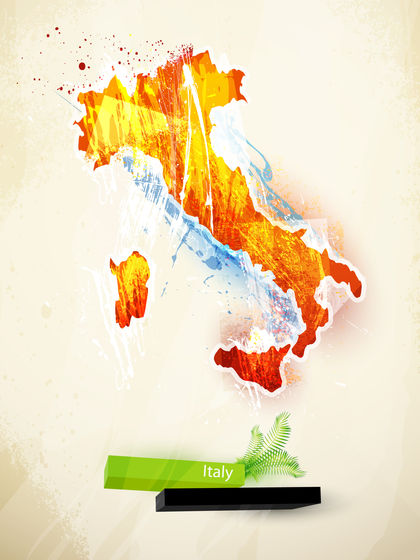Italy - Topography

Except for the fertile Po River Valley in the north and the narrow coastal belts farther south, Italy's mainland is generally mountainous, with considerable seismic activity. During Roman times, the city of Pompeii, near present-day Naples (Napoli), was devastated first by an earthquake in AD 63 and then by the famed eruption of Mt. Vesuvius (1,277 m/4,190 ft) in AD 79. In the last century, an earthquake in northeastern Italy on 6 May 1976 left more than 900 people dead, and a quake in the south on 23 November 1980 (and subsequent aftershocks) claimed at least 4,500 lives.
The Alpine mountain area in the north along the French and Swiss borders includes three famous lakes—Como, Maggiore, and Garda—and gives rise to six small rivers that flow southward into the Po. Italy's highest peaks are found in the northwest in the Savoy Alps, the Pennines, and the Graian chain. They include Mont Blanc (4,807 m/15,771 ft), on the French border; Monte Rosa (Dufourspitze, 4,634 m/15,203 ft) and the Matterhorn (Monte Cervino, 4,478 m/14,692 ft), on the Swiss border; and Gran Paradiso (4,061 m/13,323 ft). Marmolada (3,342 m/10,965 ft), in northeast Italy, is the highest peak in the Dolomites.
At the foot of the Alps, the Po River, the only large river in Italy, flows from west to east, draining plains covering about 17% of Italy's total area and forming the agricultural and industrial heartland. The Apennines, the rugged backbone of peninsular Italy, rise to form the southern border of the Po Plain. Numerous streams and a few small rivers, including the Arno and the Tiber (Tevere), flow from the Apennines to the west coast. The highest peak on the peninsula is Corvo Grande (2,912 m/9,554 ft). Vesuvius is the only active volcano on the European mainland.
While altitudes are lower in southern Italy, the Calabrian coast is still rugged. Among the narrow, fertile coastal plains, the Plain of Foggia in northern Apulia, which starts along the Adriatic, and the more extensive lowland areas near Naples, Rome, and Livorno (Leghorn) are the most important. The mountainous western coastline forms natural harbors at Naples, Livorno, La Spezia, Genoa (Genova), and Savona, and the low Adriatic coast permits natural ports at Venice (Venezia), Bari, Brindisi, and Taranto.
Sicily, separated from the mainland by the narrow Strait of Messina, has the Madonie Mountains, a continuation of the Apennines, and the Plain of Catania, the largest plain on the island. Mount Etna (3,369 m/11,053 ft) is an isolated and active volcano in the northeast.
Sardinia, in the Tyrrhenian Sea, is generally mountainous and culminates in the peak of Gennargentu (1,834 m/6,017 ft). The largest and most fertile plains are the Campidano in the south and the Ozieri in the north. The principal bay is Porto Torres in the Gulf of Asinara.
14 year old school kid,
Jesse
14 year old school kid,
Jesse
As far as the seismic activity is concerned, I would mention the earthquake that struggled L'Aquila (which is located at the foot of the western side of the Gran Sasso) on April 6th 2009, that has left nearly 300 people dead.